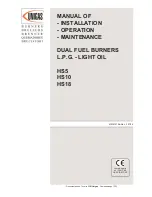
19
TWO - FLAME BURNER OPERATION
The two-flame burner always ignites at reduced fuel and air flow (1st flame) and a few seconds later change to full fuel
and air (2nd flame) flow operation.
Cutting-in of the second flame depends on control box and control device (pressure switch or thermostat) consent.
When the burner is working at full flow, it stays in this position until the pressure or temperature level at which the
control device (pressure switch or thermostat) has been set, is reached. The control device is triggered off cutting-off
the second flame (fuel and air) when the value at which the device has been set, is reached.
The burner therefore stays in operation on the first flame only.
The first flame on its own is not usually enough to maintain pressure or temperature at the desired level and consequently,
pressure or temperature drops until it reaches the level at which the second flame control device (pressure switch or
thermostat) again cuts-in total air and fuel flow (second flame).
The burner stops operating completely when, with only the first-flame cut-in, pressure or temperature reaches the level
at which the device being used (pressure switch or thermostat) open contact.
The burner automatically re-ignites when pressure or temperature drops below the level at which the pressure switch
or thermostat has been set.
WHEN SHOULD TWO-FLAME BURNERS BE USED
A two-flame burner is usually found necessary if it has to be coupled to boilers producing steam; however there may be
other reasons why two-flame burners are necessary.
For steam boilers, two-flame operation enables, to a certain extent only, the vapour quantity produced to be in line with
the actual needs of the plant, reducing ignition frequency and thus also boiler thermal stress.
This is why steam boiler manufacturers specify two-flame burners for their boilers.
It is also important to note that low pressure steam boilers (max. 0,5 bar) strictly call for two-flame burners in order to
keep working pressure sufficiently constant.
Two-flame burners are required for pressurized boilers (where combustion chamber pressure is higher than atmospheric
pressure) in order to give sufficiently gradual ignition (two-flame burners always ignite on the first flame only, which
means at reduced flow; they only change to full flow operation later on).
In these kinds of boilers, full flow ignition would cause considerable damage over a short time due to the excessive
pressure the combustion chamber would have to bear.
From what has been said above, it is quite clear that with regard to pressurized boilers, it is necessary to use burners
that can ignite automatically at reduced flow and only change to full flow operation later on
(after a few seconds).
N.B.
It is not advisable that a burner operating with a boiler for the production of water for heating purposes be
connected up for two flame operation.
In this case, when the burner is operating on one flame only (this can be over long periods, too) the boiler is
insufficiently fed; consequently, the products of combustion exit at an excessively low temperature (less than
180 °C) creating soot at the chimney outlet. When the boiler is not sufficiently fed, acid condensate and soot
formation is very likely in the boiler with the result that the boiler quickly gets clogged and corroded.
When a two-flame burner is installed in a boiler producing water for heating purposes, it must be connected to enable
two flame full-flow operation and must stop operation completely, without change-over to the first flame, when the pre-
set temperature is reached.
To achieve this type of operation, the second flame thermometer must note installed and a direct (bridge) connection
as to be effected between the relevant terminals.
In this way, only the reduced flow ignition capacity of the burner is used in order to have gradual ignition, which is
essential for boilers with combustion chamber under pressure (pressurized) but it is also very useful for boilers (nega-
tive pressure combustion chamber).
The burner control device (cutting-in and stop) depends on the usual operation and safety thermostats.
Содержание BT 75 DSNM-D
Страница 7: ...7 WORKING FIELD N 0002921710 N 0002921701 WORKING FIELD...
Страница 23: ...23 INSTRUCTIONS LAL CONTROL BOX N 7153 Rev 04 1996...
Страница 24: ...24 INSTRUCTIONS LAL CONTROL BOX N 7153 Rev 04 1996...
Страница 25: ...25 INSTRUCTIONS LAL CONTROL BOX N 7153 Rev 04 1996...
Страница 26: ...26 INSTRUCTIONS LAL CONTROL BOX N 7153 Rev 04 1996...
Страница 27: ...27 INSTRUCTIONS LAL CONTROL BOX N 7153 Rev 04 1996...
Страница 28: ...28 INSTRUCTIONS LAL CONTROL BOX N 7153 Rev 04 1996...
Страница 29: ...29 N 7153 Rev 04 1996 INSTRUCTIONS LAL CONTROL BOX...
Страница 30: ...30 N 7153 Rev 04 1996 INSTRUCTIONS LAL CONTROL BOX...
Страница 32: ......
Страница 33: ......
Страница 34: ......
Страница 35: ......
Страница 36: ......
Страница 37: ......
Страница 38: ......
Страница 39: ......









































